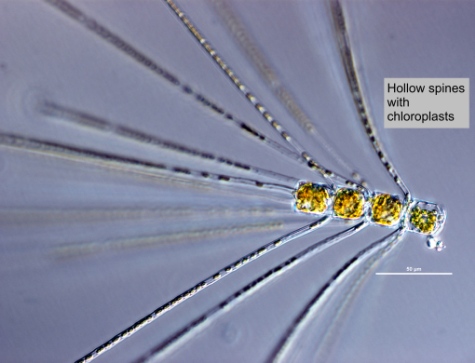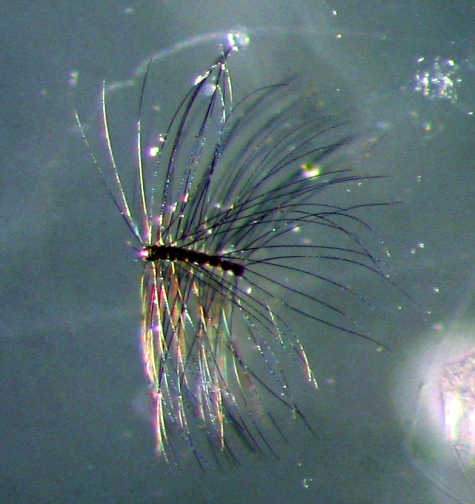




|
 |
Synonym(s)
*Sometimes referred to as C. convolutum (Guiry 2012).
Classification
(Guiry and Guiry 2012)
Lifestyle
Description
Valve
In diatoms, the structurally distinct halves of the cell wall (Becker 1996).
valves have different shapes: The top valve is rounded and has spines arising from its centre, while the bottom valve is flat and has spines arising from just inside the CloseMargin
The outline or border that defines the shape of an organism or cell.
margin. The spines are long, thick, and hollow. They are a constant width throughout and are covered in numerous tiny "spinelets". The large spines initially curve strongly towards the bottom, and then curve slightly away. CloseAperture
"In some diatoms, the space between the valves of adjacent cells in chains" (Horner 2002).
Apertures between adjacent cells are partly or completely covered by the spines. The CloseGirdle
In diatoms, the portion of the cell wall between the two valves of a cell; made up of intercalary bands (bands closest to the valves) and connecting bands (bands in the middle of the girdle). In dinoflagellates, the equivalent of a cingulum or transverse furrow (Horner 2002).
girdle is roughly ⅓ of the cell length, and there is a distinct notch between each valve and the girdle (Cupp 1943). Chloroplasts are numerous, present inside the cell as well as inside the spines (Haigh 2010). Cells are yellow-brown in colour.Measurements
Apical
(axis, spine) The region of the apex or point. Refers to the most anterior point or region of the cell (HPP 2003).
(apical axis): 10 - 27 μmLength Close
Pervalvar axis
The axis through the centre point of the two valves of a frustule. This axis is perpendicular to the valve face.
(pervalvar axis): 25 - 60 μmSpine length: up to 200 μm or more
(Hasle and Syvertsen 1997, Haigh 2010)
Similar species
Harmful effects
Distribution
Cosmopolitan, but more common in temperate regions (Hasle and Syvertsen 1997).
Common from late winter to summer off southern California, sometimes in very large numbers (Cupp 1943).
Abundant in spring and fall (Albright et al. 1992, Haigh 2010).
Growth conditions
Environmental Ranges
Temperature range (°C): -1.926 - 24.767
Nitrate (μmol L-1): 0.223 - 28.280
Salinity: up to 35.488
Oxygen (mL L-1): 4.806 - 9.192
Phosphate (μmol L-1): 0.074 - 2.337
Close
Silicic acid
A general term to describe chemical compounds containing silicon, oxygen and hydrogen with a general formula of [SiOx(OH)4-2x]n. Diatoms polymerize silicic acid into biogenic silica to form their frustules (Azam and Chisholm 1976).
Silicate (μmol L-1): 1.714 - 59.039(OBIS 2012, cited in EOL 2012)
Bloom characteristics
References
Albright, L. J., Johnson, S. and Yousif, A. 1992. Temporal and spatial distribution of the harmful diatoms Chaetoceros concavicornis and Chaetoceros convolutus along the British Columbia coast. Canadian Journal of Fisheries and Aquatic Sciences. 49(9): 1924-1931.
Cupp, E. E. 1943. Marine Plankton Diatoms of the West Coast of North America. University of California Press. Berkeley, California. 238.
Encyclopedia of Life (EOL). 2012. Chaetoceros convolutus. http://eol.org/pages/2540207/overview. Accessed 18 Mar 2012.
Guiry, M. D. 2012. Chaetoceros convolutus Castracane, 1886. http://www.marinespecies.org/aphia.php?p=taxdetails&id=156611. Accessed 18 Mar 2012.
Guiry, M. D. and Guiry, G. M. 2012. Chaetoceros convolutum Castracane. http://www.algaebase.org/search/species/detail/?species_id=37410. Accessed 18 Mar 2012.
Haigh, N. 2010. Harmful Plankton Handbook. Nanaimo, BC, Canada. 52.
Harrison, P. J., Thompson, P. A., Guo, M. and Taylor, F. J. R. 1992. Effects of light, temperature and salinity on the growth rate of harmful marine diatoms, Chaetoceros convolutus and C. concavicornis that kill netpen salmon. Journal of Applied Phycology. 5: 259-265.
Hasle, G. R. and Syvertsen, E. E. 1997. Marine diatoms. In: Tomas, C. R. (ed.) Identifying Marine Phytoplankton. Academic Press, Inc., San Diego. 5-385.
Horner, R. A. 2002. A Taxonomic Guide To Some Common Phytoplankton. Biopress Limited, Dorset Press, Dorchester, UK. 200.
Kraberg, A., Baumann, M. and Durselen, C. D. 2010. Coastal Phytoplankton: Photo Guide for Northern European Seas. Verlag Dr. Friedrich Pfeil, Munchen, Germany. 204.
Ocean Biogeographic Information System (OBIS). 2012. Chaetoceros convolutum. http://www.iobis.org/mapper/?taxon_id=419554. Accessed 18 Mar 2012.
Tester, P. A. and Mahoney, B. 1995. Implication of the diatom, Chaetoceros convolutus, in the death of red king crab, Paralithodes camtschatica, Captains Bay, Unalaska Island, Alaska. In: Lassus, P., Arzul, G., Erard-Le Denn, E., Gentien, P. and Marcaillou-Le Baut, C. (eds.) Harmful Marine Algal Blooms. Lavoisier, Paris, France. 95-100.
